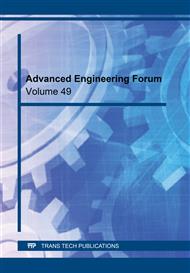[1]
He P, Fenton GA, Griffiths D. Calibration of resistance factors for gravity retaining walls. Georisk: Assessment and Management of Risk for Engineered Systems and Geohazards 2022:1-9.
DOI: 10.1080/17499518.2022.2083180
Google Scholar
[2]
Goh A, Zhang F, Zhang W, Zhang Y, Liu H. A simple estimation model for 3D braced excavation wall deflection. Computers and Geotechnics 2017;83:106-13.
DOI: 10.1016/j.compgeo.2016.10.022
Google Scholar
[3]
Zhou X, Xie Y, Huang X, He H. Antislip stability analysis of gravity retaining wall by probabilistic approach. International Journal of Geomechanics 2019;19:04019045.
DOI: 10.1061/(asce)gm.1943-5622.0001413
Google Scholar
[4]
Sert S, Luo Z, Xiao J, Gong W, Juang CH. Probabilistic analysis of responses of cantilever wall-supported excavations in sands considering vertical spatial variability. Computers and Geotechnics 2016;75:182-91.
DOI: 10.1016/j.compgeo.2016.02.004
Google Scholar
[5]
Luo Z, Li Y, Zhou S, Di H. Effects of vertical spatial variability on supported excavations in sands considering multiple geotechnical and structural failure modes. Computers and Geotechnics 2018;95:16-29.
DOI: 10.1016/j.compgeo.2017.11.017
Google Scholar
[6]
Guha Ray A, Baidya D. Reliability coupled sensitivity based design approach for gravity retaining walls. Journal of The Institution of Engineers (India): Series A 2012;93:193-201.
DOI: 10.1007/s40030-013-0023-1
Google Scholar
[7]
Baidya D, GuhaRay A. Geotechnical Engineering Reliability Aspects". 2017.
Google Scholar
[8]
Magnan J-P. Les méthodes statistiques et probabilistes en mécanique des sols: Presses Ponts et Chaussées; 1982.
Google Scholar
[9]
Amouzou GY, Soulaïmani A. Numerical Algorithms for Elastoplacity: Finite Elements Code Development and Implementation of the Mohr–Coulomb Law. Applied Sciences 2021;11:4637.
DOI: 10.3390/app11104637
Google Scholar
[10]
MAGNAN J-P, MESTAT P. Lois de comportement et modélisation des sols: Ed. Techniques Ingénieur; 1997.
DOI: 10.51257/a-v1-c218
Google Scholar
[11]
Mokeddem A. Modélisation géomécanique et probabiliste des rideaux de palplanches: prise en compte de l'interaction sol-structure et de la variabilité spatiale du sol: Université de Bordeaux; 2018.
DOI: 10.3406/ecoru.1999.5135
Google Scholar
[12]
Costet J, Sanglerat G. Cours pratique de mécanique des sols, Tome 2, Calcul des ouvrages. Imprimerie Gauthier-Villars, Paris 1983.
Google Scholar
[13]
Mestat P, Humbert P, Dubouchet A. Recommandations pour la vérification de modèles d'éléments finis en géotechnique. BULLETIN-LABORATOIRES DES PONTS ET CHAUSSEES 2000:33-52.
Google Scholar
[14]
Dhatt G, Touzot G, Lefrançois E. Méthode des éléments finis: Lavoisier; 2005.
Google Scholar
[15]
Mestat P. Maillages d'éléments finis pour les ouvrages de géotechnique. Conseils et recommandations. Bulletin-Laboratoires des Ponts et Chaussées 1997:39-64.
Google Scholar
[16]
Debard Y. Méthode des éléments finis: élasticité plane. Institut Universitaire de Technologie du Mans 2009.
Google Scholar
[17]
Humbert P, Dubouchet A, Fezans G, Remaud D. CESAR-LCPC, un progiciel de calcul dédié au génie civil. Bulletin des laboratoires des ponts et chaussées 2005;256:7-37.
Google Scholar
[18]
Varga R, Jelušič P. Failure Probability of an Optimally Designed Gravity Retaining Wall. ASCE-ASME Journal of Risk and Uncertainty in Engineering Systems, Part A: Civil Engineering 2022;8:04022007.
DOI: 10.1061/ajrua6.0001223
Google Scholar


